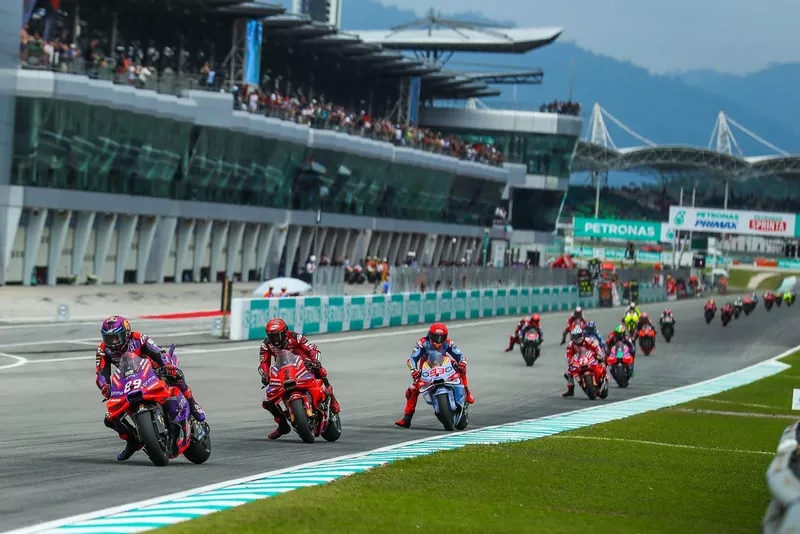Should MotoGP Reconsider Its Emphasis on Sprint Races?
MotoGP’s decision to add sprint races to every race weekend in 2023 was bold, exciting, and aimed at increasing viewership and engagement in the sport. Modeled after the success of sprint formats in Formula 1 and other racing leagues, MotoGP hoped that these shorter, high-stakes races would bring more action and appeal to fans. However, as we head deeper into the season, both the positives and drawbacks of the sprint race format have come into sharper focus. This has sparked a debate within the MotoGP community on whether the emphasis on sprint races is the best direction for the sport.

Here, we’ll take a closer look at how sprint races have impacted the sport, the positives and challenges they’ve brought, and whether MotoGP should reconsider or adjust its approach to sprint races.
The Benefits of Sprint Races
1. Increased Excitement for Fans
Sprint races provide fans with an additional day of high-stakes racing action, amplifying the excitement over a three-day race weekend. With points awarded in the sprints, these races have a direct impact on the championship standings, making each session meaningful and engaging for fans. The shorter, intense format also tends to create more wheel-to-wheel action, leading to thrilling finishes and dramatic moments that traditional qualifying sessions can lack.
2. Greater Viewership and Marketability
The addition of sprint races was partly motivated by the desire to expand MotoGP’s reach, especially with newer and younger audiences. Sprint races offer a more digestible racing format that may appeal to casual fans who might find full-length races too time-consuming. With more content to show over the weekend, broadcast rights become more valuable, and MotoGP’s brand can potentially gain more exposure globally.
3. Revamping Championship Dynamics
By introducing a new format where riders can earn points twice per weekend, sprint races have added layers to the championship strategy. A poor qualifying session or mechanical issue can now be somewhat offset by points earned in a sprint race, offering riders a way to stay in the title hunt. This has introduced a fresh strategic dimension to the sport, making each weekend unpredictable and competitive.
Challenges of the Sprint Race Format
1. Increased Physical and Mental Toll on Riders
One of the biggest criticisms from riders is the increased strain of racing at maximum intensity on two separate occasions each weekend. MotoGP riders already push their physical limits during standard races, and the sprint races add extra stress, which has raised concerns over fatigue and the risk of injuries. With incidents becoming more common due to the aggressive nature of sprints, many riders feel that they are being pushed too hard, too often, potentially compromising their safety.
2. Impact on Race Strategy and Consistency
The shorter race format requires an all-out approach from the very beginning, as there’s little time to make up lost ground in a sprint. This encourages riskier overtakes and more aggressive tactics, which can sometimes compromise the integrity of the main race on Sunday. Riders who suffer crashes or mechanical issues during a sprint may be at a disadvantage for the main race, leading to criticism that the championship could be overly influenced by these short bursts of action rather than consistent performance across full races.
3. Increased Demands on Teams and Equipment
The sprint races also place a significant burden on teams and their equipment. Teams now face the challenge of preparing bikes for both short sprints and longer races, demanding greater efficiency in terms of bike setup, fuel management, and tire strategy. Not only does this increase costs, but it also risks placing smaller, less-funded teams at a disadvantage, as they may lack the resources to fully optimize performance across both race formats.
Should MotoGP Reconsider the Sprint Race Emphasis?
The introduction of sprint races has certainly brought added excitement and visibility to MotoGP, achieving some of the objectives Dorna Sports set out with this change. Yet, the new format has come with consequences that need to be addressed if sprint races are to become a sustainable part of the MotoGP weekend. Here are some considerations for the future of sprint races in MotoGP.
1. Adjusting the Frequency of Sprint Races
One option is to reduce the frequency of sprint races to a select few weekends throughout the season. This would preserve the excitement they bring without overloading riders and teams. Similar to how Formula 1 handles its sprint races, a more selective schedule could also make each sprint feel like a special event.
2. Revisiting Points Distribution
Another potential adjustment could be changing the points awarded for sprint races. If the stakes were slightly lower, riders might approach sprint races with a more balanced strategy, potentially reducing the risk of crashes and allowing teams to better manage resources.
3. Enhanced Safety Measures
If sprint races are here to stay, MotoGP may need to work on additional safety measures or protocols. This could include developing better protective equipment for riders or revisiting race start procedures to reduce the risks associated with the intense, short-format racing.
Sprint races have undoubtedly added an exhilarating dimension to MotoGP, transforming race weekends into multi-day events with unpredictable outcomes. For fans, the added drama has been a major draw, and for the sport, it’s been an effective way to boost engagement and viewership. However, the additional demands on riders, teams, and equipment are undeniable, and balancing these factors is essential to ensure that MotoGP maintains its appeal without compromising rider safety or the quality of the competition.
Ultimately, MotoGP may not need to eliminate sprint races but instead fine-tune the format to better serve all stakeholders. With adjustments to the frequency, points system, or safety protocols, sprint races could continue to bring excitement without causing burnout among riders and teams. As the 2023 season serves as a testing ground, it will be interesting to see how MotoGP adapts to feedback and whether sprint races become a refined fixture in the championship’s future.



